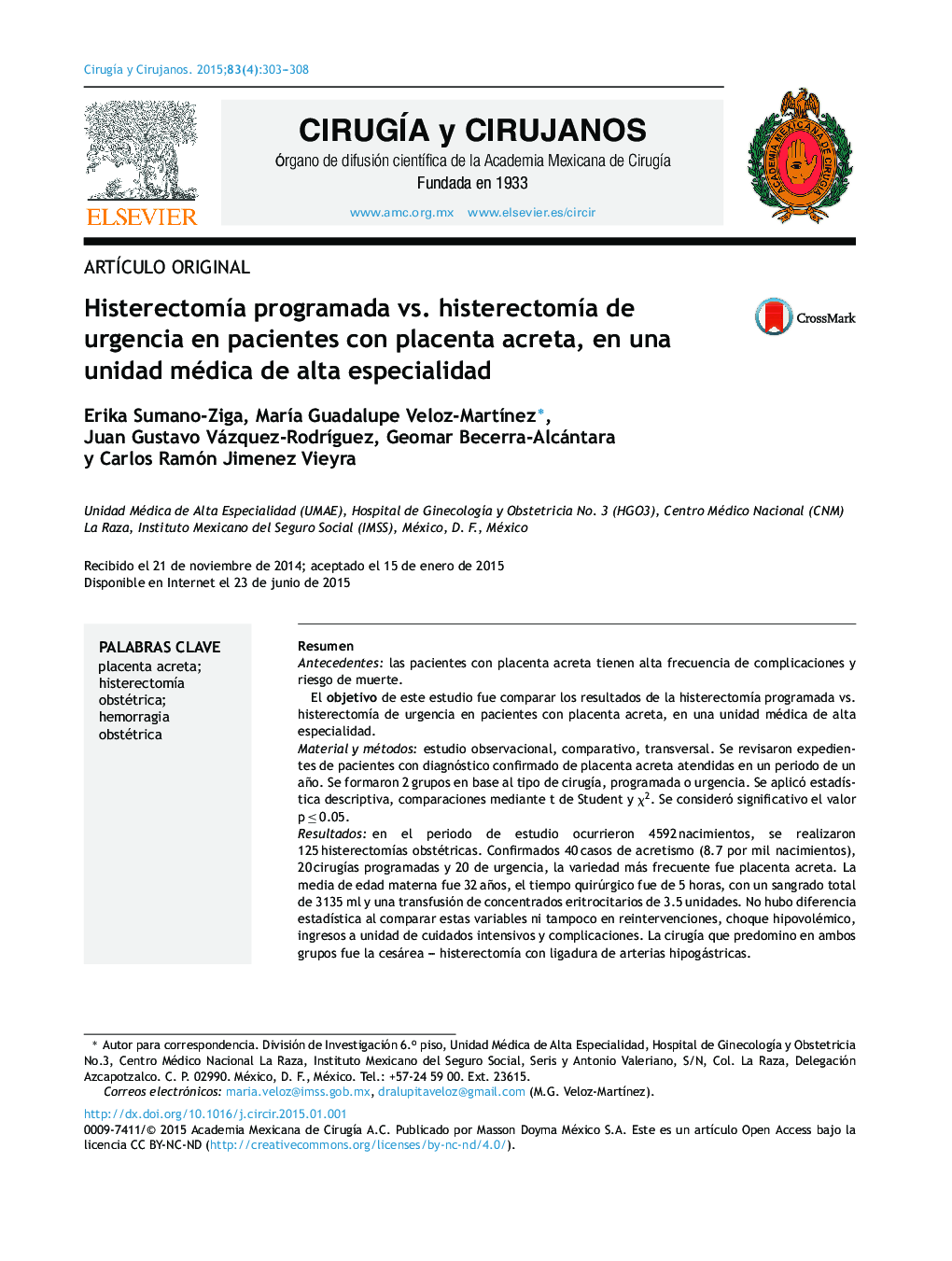| Article ID | Journal | Published Year | Pages | File Type |
|---|---|---|---|---|
| 4283243 | Cirugía y Cirujanos | 2015 | 6 Pages |
ResumenAntecedenteslas pacientes con placenta acreta tienen alta frecuencia de complicaciones y riesgo de muerte.El objetivo de este estudio fue comparar los resultados de la histerectomía programada vs. histerectomía de urgencia en pacientes con placenta acreta, en una unidad médica de alta especialidad.Material y métodosestudio observacional, comparativo, transversal. Se revisaron expedientes de pacientes con diagnóstico confirmado de placenta acreta atendidas en un periodo de un año. Se formaron 2 grupos en base al tipo de cirugía, programada o urgencia. Se aplicó estadística descriptiva, comparaciones mediante t de Student y χ2. Se consideró significativo el valor p ≤ 0.05.Resultadosen el periodo de estudio ocurrieron 4592 nacimientos, se realizaron 125 histerectomías obstétricas. Confirmados 40 casos de acretismo (8.7 por mil nacimientos), 20 cirugías programadas y 20 de urgencia, la variedad más frecuente fue placenta acreta. La media de edad materna fue 32 años, el tiempo quirúrgico fue de 5 horas, con un sangrado total de 3135 ml y una transfusión de concentrados eritrocitarios de 3.5 unidades. No hubo diferencia estadística al comparar estas variables ni tampoco en reintervenciones, choque hipovolémico, ingresos a unidad de cuidados intensivos y complicaciones. La cirugía que predomino en ambos grupos fue la cesárea – histerectomía con ligadura de arterias hipogástricas.Conclusionesen este hospital el tratamiento quirúrgico programado y urgente de pacientes con acretismo placentario muestra resultados similares, probablemente debido a la disponibilidad continua de recursos y a la experiencia que ha adquirido el equipo multidisciplinario en todos turnos. Pese a ello siempre debe procurarse realizar la cirugía programada disponiendo de todos los recursos necesarios.
BackgroundPatients with placenta accreta have a high frequency of complications and death risk.ObjectiveThe aim of this study was to compare the results of scheduled hysterectomy vs. urgent hysterectomy in patients with placenta accreta in a high specialty medical unit.Material and methodsAn observational, comparative, cross-sectional study was conducted by reviewing patient records with confirmed diagnostic of placenta accreta, who attended in a one year period. They were divided into 2 groups based on the type of surgery, scheduled or urgent. Descriptive statistics were applied, with comparisons using Student t-test and chi squared tests. A value of P<.05 was considered significant.ResultsThere were 4,592 births in the period of study, and 125 obstetric hysterectomies were performed, with 40 confirmed cases of accreta (8.7 per thousand births) with 20 in scheduled and 20 in urgent surgeries, with the most frequent type being placenta accreta. The mean maternal age was 32 years, with a mean of 5 hours operating time, total bleeding 3135 ml, and 3.5 units of packed cells transfused. There was no statistical difference when comparing these variables with re-interventions, hypovolaemic shock, and intensive care unit admission. Caesarean-hysterectomy with hypogastric artery ligation was the most frequent surgery performed.ConclusionsIn this hospital, scheduled and urgent surgical treatment of patients with placenta accreta show similar results, probably because the constant availability of resources and the experience obtained by the multidisciplinary team in all shifts. Nevertheless, make absolutely sure to perform elective surgery while having all the necessary resources.
